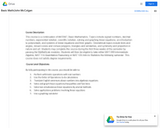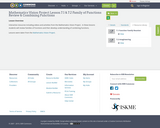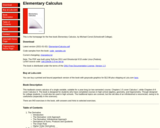
Discussion on explaining parabolas.
- Subject:
- Algebra
- Mathematics
- Material Type:
- Lecture
- Provider:
- Step-by-Step Science
- Date Added:
- 11/23/2016

Discussion on explaining parabolas.

This seminar will help you to understand how the graph of a function relates to the function itself, and how to determine the domain and range of a function by examining its graph. It is necessary to be able to determine a function’s domain and range in order to understand how different functions are restricted by their rules. Understanding how to visually interpret functions by looking at their graphs will also allow you to quickly gather important information about the function. StandardsCC.2.2.HS.C.2 Graph and analyze functions and use their properties to make connections between the different representations.

This seminar will introduce you to various properties that are used to simplify expressions containing exponents. You will learn how to multiply and divide expressions containing exponents, and you will also learn what happens when a base is raised to a power of zero. You will have to extend your knowledge of an exponent as an indicator of how many factors of a base must be multiplied, and apply it to combining more than one exponential expression using various operations. This will be achieved by both visually studying the factors, and also applying the properties to concepts such as banking and interest.StandardsCC.2.1.HS.F.1Apply and extend the properties of exponents to solve problems with rational exponents.

In this seminar you will learn how to simplify square roots whose radicands contain factors that are perfect squares. You will learn how to perform these operations on both integers and variables. You will be able to do this by learning how to identify factors that are perfect squares. These will be necessary skills as you continue to perform operations that contain radical expressions. StandardsCC.2.2.8.B.1Apply concepts of radicals and integer exponents to generate equivalent expressions.

This course relies on primary readings from the database community to introduce graduate students to the foundations of database systems, focusing on basics such as the relational algebra and data model, schema normalization, query optimization, and transactions. It is designed for students who have taken 6.033 (or equivalent); no prior database experience is assumed, though students who have taken an undergraduate course in databases are encouraged to attend.

In this project, you will explore a real-world problem, and then work through a series of steps to analyze that problem, research ways the problem could be solved, then propose a possible solution to that problem. Often, there is no specific right or wrong solutions, but sometimes one particular solution may be better than others. The key is making sure you fully understand the problem, have researched some possible solutions, and have proposed the solution that you can support with information / evidence.Begin by reading the problem statement in Step 1. Take the time to review all of the information provided in the statement, including exploring the websites, videos and / or and articles that are linked. Then work on steps 2 through 8 to complete this problem-based learning experience.

Understanding adding and subtracting polynomials.StandardsCC.2.2.HS.D.3Extend the knowledge of arithmetic operations and apply to polynomials.

This course is a continuation of MAT087, Basic Mathematics. Topics include signed numbers, decimal numbers, exponential notation, scientific notation, solving and graphing linear equations, an introduction to polynomials, and systems of linear equations and their graphs. Geometrical topics include lines and angles, closed curves and convex polygons, triangles and similarities, and symmetry and proportion in nature and art. Students may complete this course during the first three weeks of the semester by passing the MyMathLab modules. Students will then be eligible to take either MAT 099 Intermediate Algebra, MAT 114-Quantitative Reasoning or MAT 120-Intro to Statistics the following semester. This course does not satisfy degree requirements.

This is a text on elementary multivariable calculus, designed for students who have completed courses in single-variable calculus. The traditional topics are covered: basic vector algebra; lines, planes and surfaces; vector-valued functions; functions of 2 or 3 variables; partial derivatives; optimization; multiple integrals; line and surface integrals.

The Mathematics of Nutrition Science is a workbook designed to integrate and contextualize developmental mathematics into an introductory college level Nutrition class. Definitions and skills from Community College Level Elementary Algebra and Quantitative Literacy courses are explained through examples analyzing the nutritional content of different foods. The book contains exercises for students to practice these skills, and also to reflect on the concepts through short writing assignments aligned with developmental English. These materials could be used by Nutrition course instructor in many different ways, and are designed to be self-contained and require minimal mathematical instruction.

In this students will develop their knowledge of transformations as it applies to all functions. This lesson focuses on linear, quadratic, absolute value, exponential and radical functions. Students will need access to internet and graphing utilities.I have included the assessment I used to asses this unit. See "Resources" tab in the right.

Interactive resources including videos and activities from the Mathematics Vision Project. In these lessons students will review Families of Functions and then develop understanding of combining functions.Lessons were taken from the Mathematics Vision Project.

This textbook covers calculus of a single variable, suitable for a year-long (or two-semester) course. Chapters 1-5 cover Calculus I, while Chapters 6-9 cover Calculus II. The book is designed for students who have completed courses in high-school algebra, geometry, and trigonometry. Though designed for college students, it could also be used in high schools. The traditional topics are covered, but the old idea of an infinitesimal is resurrected, owing to its usefulness (especially in the sciences).

In this project, you will explore a real-world problem, and then work through a series of steps to analyze that problem, research ways the problem could be solved, then propose a possible solution to that problem. Often, there are no specific right or wrong solutions, but sometimes one particular solution may be better than others. The key is making sure you fully understand the problem, have researched some possible solutions, and have proposed the solution that you can support with information / evidence.Begin by reading the problem statement in Step 1. Take the time to review all the information provided in the statement, including exploring the websites, videos and / or articles that are linked. Then work on steps 2 through 8 to complete this problem-based learning experience.

Functional analysis helps us study and solve both linear and nonlinear problems posed on a normed space that is no longer finite-dimensional, a situation that arises very naturally in many concrete problems. Topics include normed spaces, completeness, functionals, the Hahn-Banach Theorem, duality, operators; Lebesgue measure, measurable functions, integrability, completeness of Lᵖ spaces; Hilbert spaces; compact and self-adjoint operators; and the Spectral Theorem.

In this seminar you will learn how to graph quadratic functions and how to use these graphs to identify the roots, or solutions, of the function. You will learn how to use different arrangements of the equation in order to locate specific, important points for the graph. You will also learn why the intercepts of the function translate to solutions of the equation. StandardsCC.2.2.HS.C.5Construct and compare linear, quadratic, and exponential models to solve problems,

This is an advanced topics course in model theory whose main theme is simple theories. We treat simple theories in the framework of compact abstract theories, which is more general than that of first order theories. We cover the basic properties of independence (i.e., non-dividing) in simple theories, the characterization of simple theories by the existence of a notion of independence, and hyperimaginary canonical bases.

This seminar will teach you how to perform the four basic mathematical operations on expressions containing radicals. It will also show you how to rationalize the denominator of a fraction that contains radicals. You will apply your knowledge of factorization and perfect squares of both integers and variables in order to simplify the radicals. You will extend your knowledge of simplifying expressions to include those that contain radicals. You will rationalize denominators in order to place expressions in simplest radical form.StandardsCC.2.2.8.B.1Apply concepts of radicals and integer exponents to generate equivalent expressions.

Calculus Revisited is a series of videos and related resources that covers the materials normally found in freshman- and sophomore-level introductory mathematics courses. Multivariable Calculus is the second course in the series, consisting of 26 videos, 4 Study Guides, and a set of Supplementary Notes. The series was first released in 1971 as a way for people to review the essentials of calculus. It is equally valuable for students who are learning calculus for the first time.
About the Instructor
Herb Gross has taught math as senior lecturer at MIT and was the founding math department chair at Bunker Hill Community College. He is the developer of the Mathematics As A Second Language website, providing arithmetic and algebra materials to elementary and middle school teachers.
Acknowledgements
Funding for this resource was provided by the Gabriella and Paul Rosenbaum Foundation.
Other Resources by Herb Gross
Calculus Revisited: Single Variable Calculus
Calculus Revisited: Complex Variables, Differential Equations, and Linear Algebra

In this seminar will learn how to use the Quadratic Formula to solve quadratic equations. You will learn to place quadratic equations into the appropriate form in order to use the formula, and you will be shown how to correctly interpret the structure of the formula so that all of the calculations are performed correctly. You will have to apply correct and careful order of operations in order to correctly simplify the radicals. You will apply techniques you have learned to simplify radical expressions. You will then interpret your solutions not only as solutions to the equation, but then translate that information to understand how it relates to the graph of the parabola that represents the function.StandardsCC.2.2.HS.C.5Construct and compare linear, quadratic, and exponential models to solve problems.